The Indian courser (Cursorius coromandelicus) is a remarkable avian resident of South Asia’s semi-arid landscapes, captivating enthusiasts and scientists with unique adaptations and behaviors.
Characterized by sandy-brown plumage and adorned with a chestnut crown and distinctive black eye stripe, this ground-dwelling bird navigates its habitat with agility and grace.
Preferring open scrub, fallow land, and dry cultivation areas, the Indian courser showcases its adept foraging skills, primarily feeding various insects.
Breeding from March to August, it lays its camouflaged eggs in scrapes on stony ground, contributing to its cryptic existence.
Despite facing threats from habitat loss due to human activities, the Indian courser’s resilience and significance underscore the urgency for conservation efforts to safeguard this captivating species and its semi-desert habitat.
Physical Characteristics of the Indian Courser
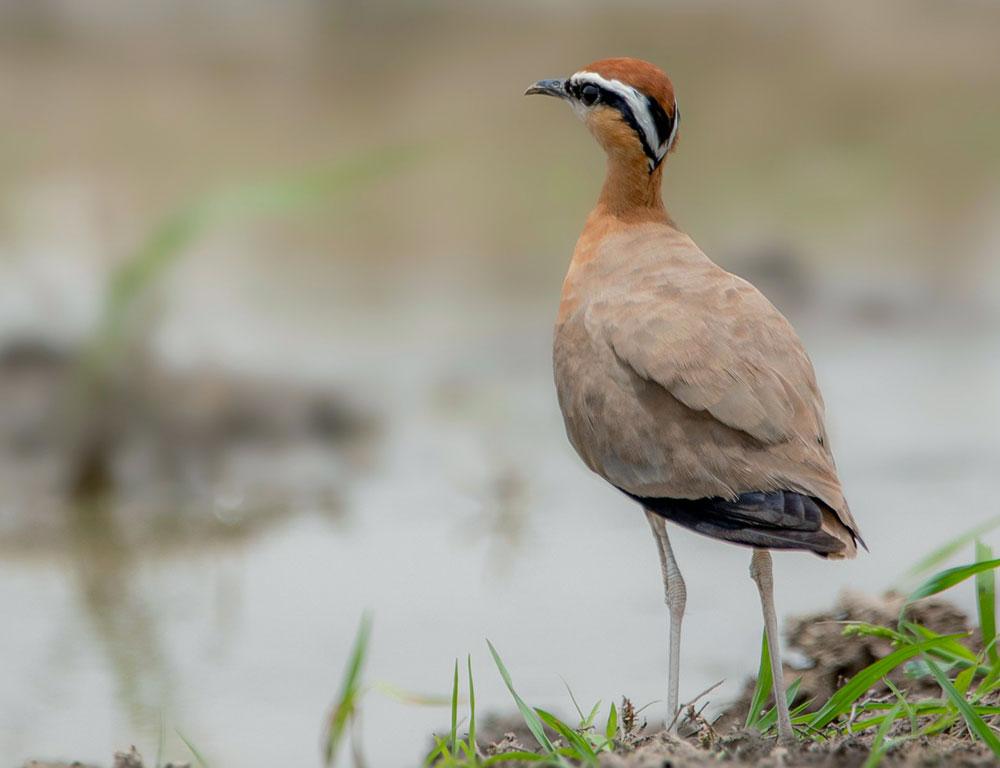
The Indian courser (Cursorius coromandelicus) possesses several distinctive physical characteristics that equip it for life in its arid habitat. Here are the key features:
Size
The Indian courser is a medium-sized bird, measuring approximately 55 to 60 centimeters (22 to 24 inches) in length. It has a slender build and long legs, which are well-suited for its ground-dwelling lifestyle.
Coloration
This bird displays a subtle yet striking color palette. It typically has sandy-brown plumage, which provides excellent camouflage against its arid surroundings. The plumage is adorned with intricate patterning and slight variations in shades, contributing to its cryptic appearance.
Head and Facial Features
The Indian courser’s head is adorned with a chestnut crown, subtly contrasting the rest of its plumage. Its face features a distinctive black eye stripe that extends from the base of the beak to the eyes, providing a striking contrast against its lighter-colored face.
Eye
The eyes of the Indian courser are relatively large and positioned well on the sides of its head, providing it with excellent peripheral vision—a crucial adaptation for detecting predators and prey in its open habitat.
Beak
It has a moderately long, slender beak, which is well-suited for capturing its insect prey. The beak is typically dark in color, complementing the bird’s overall appearance.
Legs and Feet
The Indian courser’s most notable feature is its long, slender legs, which are whitish. These legs are adapted for rapid running, allowing the bird to navigate its habitat swiftly in search of food. Its three forward-pointing toes aid in stability and balance while running.
Flight
While primarily a ground-dwelling bird, the Indian courser is capable of flight. It displays broad, rounded wings and a short tail when in flight. Its flight feathers are predominantly brown, providing effective camouflage against the terrain below.
Breeding and Nesting Behavior of the Indian Courser
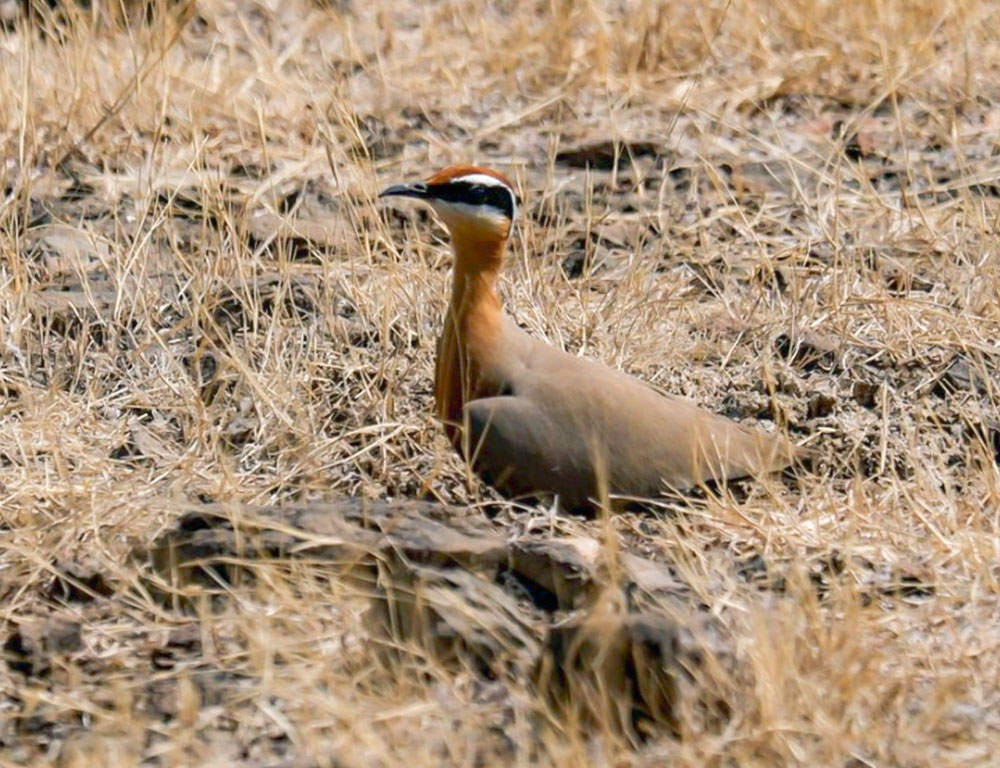
The Indian courser (Cursorius coromandelicus) is predominantly found in the dry, open semi-desert regions within the plains bounded by the Ganges and Indus river systems.
Here’s a detailed overview of its habitat and distribution:
Habitat
- Semi-Desert Regions: The Indian courser thrives in semi-desert habitats characterized by arid or semi-arid conditions. These habitats typically feature sparse vegetation, stony or rocky terrain, and limited water sources.
- Open Plains: It prefers open plains with minimal vegetation cover, where it can easily maneuver and forage for food. Scrubby vegetation, fallow land, and dry cultivation areas are among its favored habitat types.
- Scrublands: Scrublands with scattered shrubs and bushes also serve as suitable habitats for the Indian courser. These areas provide cover and nesting sites while offering ample space for the bird to search for food.
- Fallow Lands: Agricultural fallow lands, especially those with stubbly or uncultivated fields, are often frequented by Indian coursers. Such areas harbor a rich diversity of insect life, which forms the primary diet of these birds.
Distribution
- South Asia: The Indian courser’s range spans mainland South Asia, encompassing regions from the Indus Valley in the west to Bangladesh in the east.
- Peninsular India: It is widely distributed across the Indian subcontinent, extending from the northern plains to the tip of Peninsular India.
This includes states such as Rajasthan, Gujarat, Madhya Pradesh, Maharashtra, Karnataka, Andhra Pradesh, Telangana, and Tamil Nadu. - Sri Lanka: While primarily found in mainland South Asia, Indian coursers have occasionally been recorded in the dry zones of northern Sri Lanka.
- Specific Habitat Preferences: Within its range, the Indian courser prefers particular microhabitats characterized by open, dry environments. These include grasslands, scrublands, fallow lands, and dry agricultural fields.
Diet and Feeding Behavior of the Indian Courser
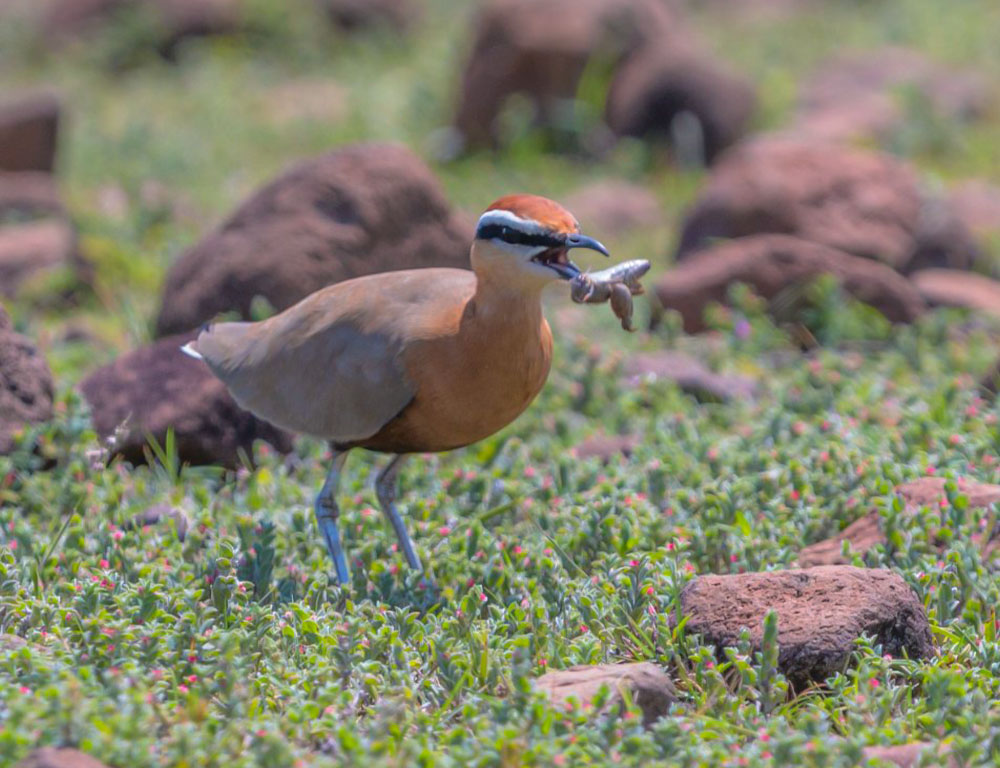
The Indian courser (Cursorius coromandelicus) has a specialized diet and feeding behavior adapted to its semi-arid habitat.
Here are the key aspects of its diet and feeding behavior:
Primary Diet
The Indian courser primarily feeds on insects, with a diet consisting mainly of termites, beetles, crickets, and grasshoppers. These insects are abundant in its habitat and provide essential nutrients for the bird’s survival.
Foraging Technique
The Indian courser employs a distinctive foraging technique characterized by rapid running and intermittent pausing. It moves in short bursts across the ground, using its agile legs to cover extensive areas in search of prey.
When it detects potential food items, it pauses briefly to peck at them before continuing its search.
Habitat Preferences
This ground-dwelling bird prefers open scrub, fallow land, and dry cultivation habitats foraging. These habitats typically harbor a rich diversity of insect life, providing ample food sources for the Indian courser.
Picking Insects
The Indian courser picks up insects from the ground, often targeting areas with sparse vegetation where insects are more exposed. It may also probe into the soil or leaf litter to uncover hidden prey items.
Efficient Resource Utilization
By covering extensive areas and actively searching for prey, the Indian courser maximizes its chances of locating and capturing insects. Its specialized foraging behavior allows it to exploit the resources available in its arid environment efficiently.
Breeding and Nesting Behavior of the Indian Courser
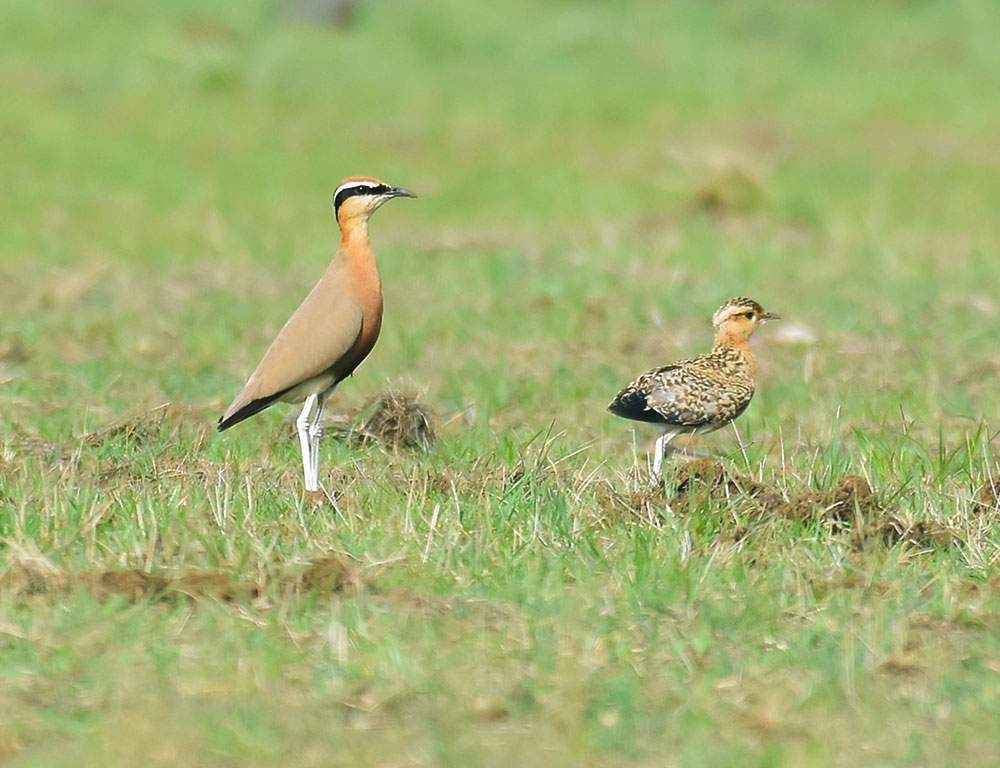
The breeding and nesting behavior of the Indian courser (Cursorius coromandelicus) offer insights into the species’ reproductive strategies and adaptation to its arid habitat:
Breeding Season
The Indian courser primarily breeds from March to August, with nesting records observed from mid-May in southern India, Sri Lanka, and mid-April in specific regions like Darbhanga.
Nesting Site
Nesting behavior typically involves the female laying two or three speckled and well-camouflaged eggs in a scrape on bare, stony ground. This choice of nesting site provides camouflage and protection for the eggs against potential predators.
Egg Characteristics
The eggs of the Indian courser are adeptly camouflaged to blend into their surroundings, making them less visible to predators. Their speckled appearance helps conceal them within the stony ground where they are laid.
Parental Care
Both male and female course parents actively incubate the eggs and care for the chicks. Adults do not call or display when approached near the nest or chicks, likely to avoid drawing attention to the vulnerable offspring.
Chick Development
After hatching, the chicks are protectively colored and remain immobile on alarm, making them challenging to detect. Initially, they rely on parental care, with the adults feeding them until they can forage independently, which typically begins after about a week.
Habitat Preferences
The Indian courser favors open scrub, fallow land, and dry cultivation habitats for breeding and nesting.
These arid and open environments provide suitable conditions for nesting and raising offspring but are increasingly threatened by human activities such as construction and agriculture.
Conservation Status of the Indian Courser
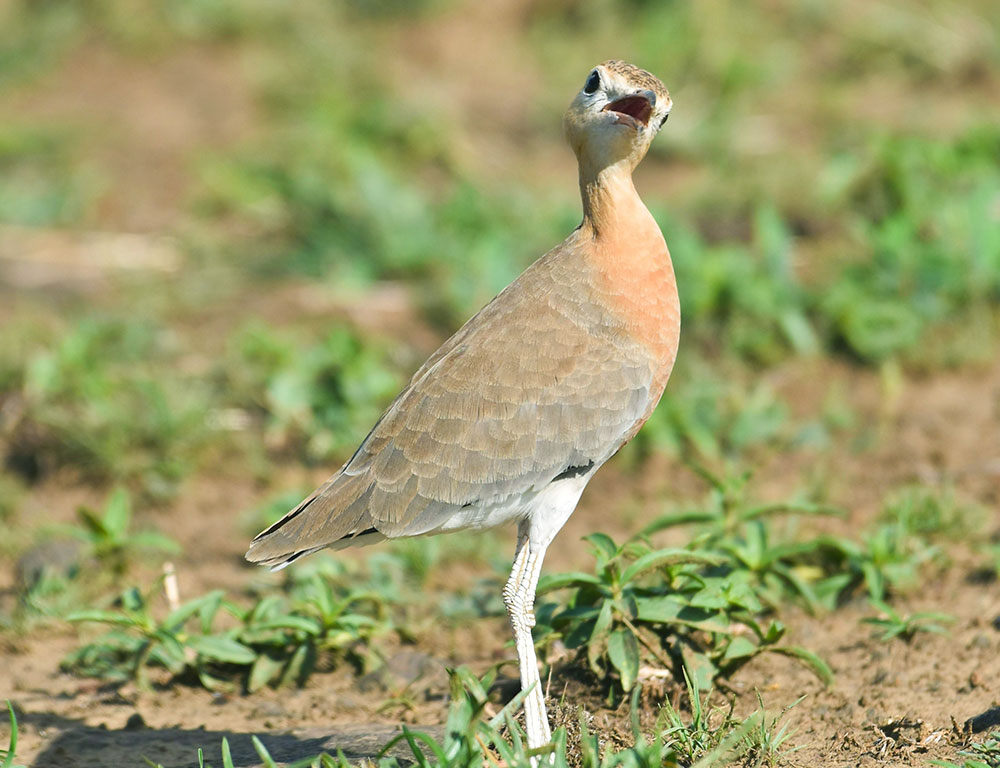
The Indian courser (Cursorius coromandelicus) currently lacks a specified conservation status on the IUCN Red List. However, despite this absence of formal classification, the species faces numerous threats due to human activities, necessitating conservation attention.
Threats
- Habitat Loss: Human activities such as construction, agricultural expansion, and industrialization have led to the degradation and loss of the Indian courser’s natural habitat. These birds require low grassland or scrubland habitats for foraging, which are increasingly being converted for human use.
- Pollution: Pollution from industrial activities and agricultural practices poses a significant threat to the Indian courser. Pesticide use in agriculture diminishes the bird’s insect food sources and exposes them to harmful chemicals, impacting their health and reproductive success.
- Industrialization: Rapid industrialization in semi-arid regions further exacerbates habitat degradation and pollution. The introduction of pollutants into these environments can have detrimental effects on the Indian courser’s well-being.
Conservation Implications
Despite lacking a formal conservation status, the Indian courser’s unique adaptations and ecological importance underscore the need for effective conservation strategies.
Conservation efforts should focus on:
- It protects and restores the bird’s natural habitats through habitat conservation and restoration initiatives.
- We are implementing sustainable land management practices to mitigate habitat loss and degradation.
- It monitors and regulates pesticide use in agricultural areas to minimize harm to the Indian courser and its prey.
- She is raising awareness among local communities, policymakers, and stakeholders about the importance of conserving the Indian courser and its habitat.
Taxonomy and Name Origin of the Indian Courser
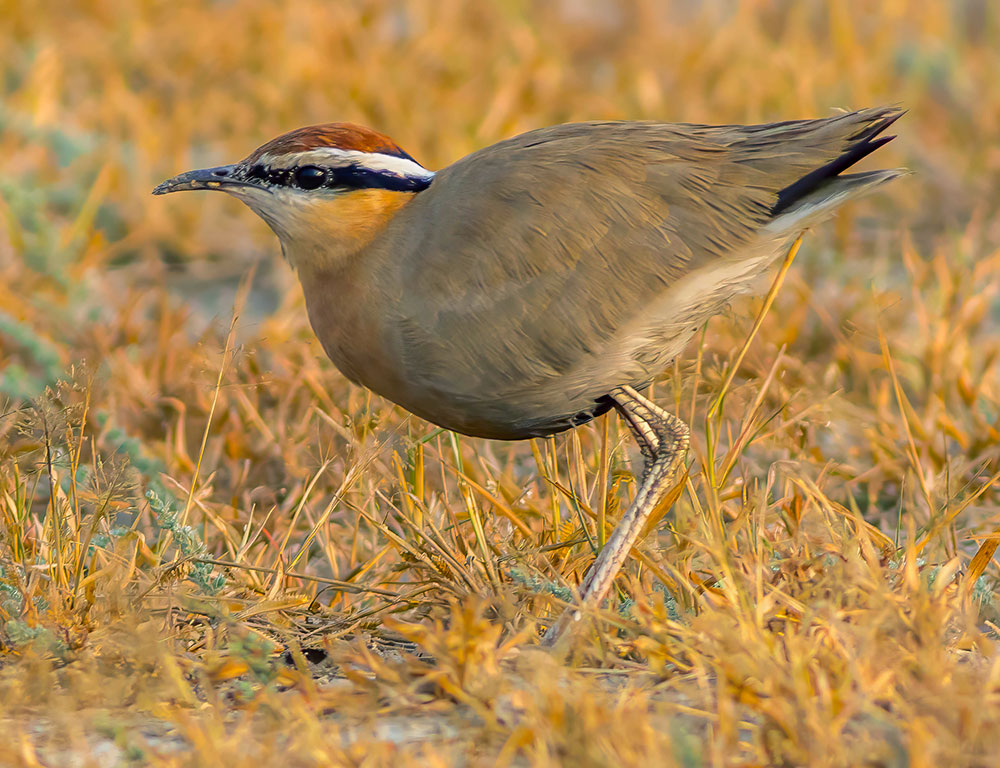
The taxonomy and name origin of the Indian courser (Cursorius coromandelicus) are fascinating aspects of its classification and nomenclature:
Formal Description
The Indian courser was officially described by the renowned German naturalist Johann Friedrich Gmelin in 1789. Gmelin’s documentation provided the foundation for understanding this species within the scientific community.
Genus Placement
Initially, the Indian courser was classified under the genus Charadrius, a diverse genus that includes various plover species.
However, through further taxonomic analysis and revisions, it was reclassified under the genus Cursorius, which is specific to coursers, a group of ground-dwelling birds.
Specific Epithet
The species epithet, coromandelicus, holds significance in tracing the bird’s origins. It is derived from the term “Coromandel Coast,” which refers to the southeastern coast of India.
This epithet reflects the geographical region where the Indian courser was first observed and documented.
Superspecies and Relationships of Indian Courser
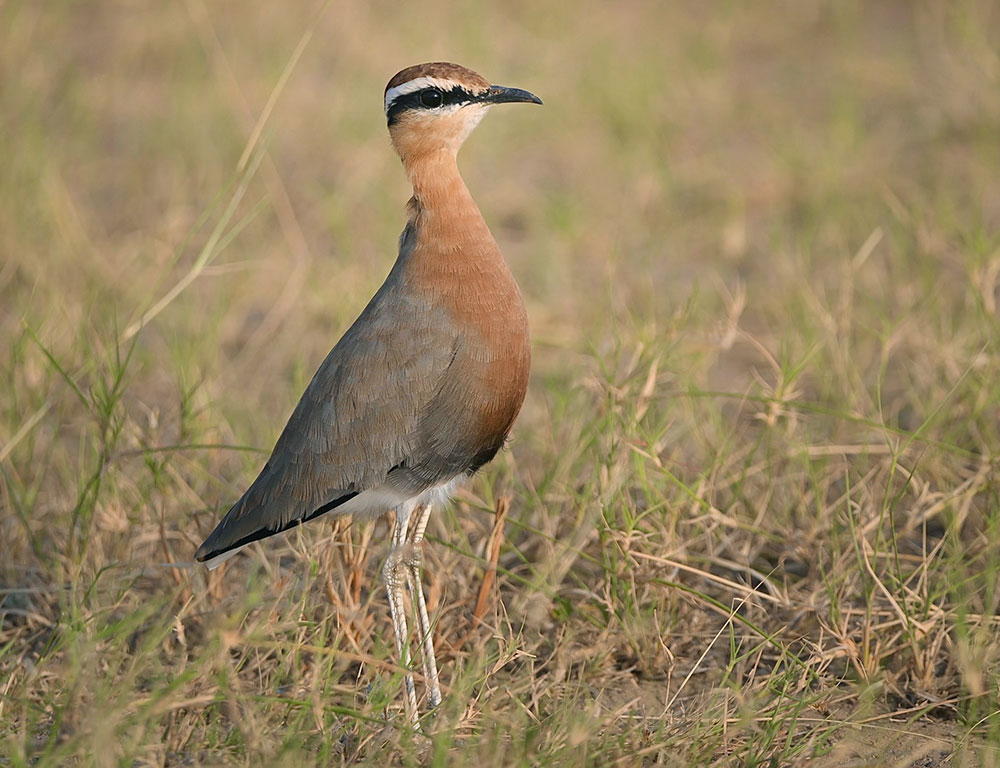
The Indian courser (Cursorius coromandelicus) is part of a fascinating group known as a superspecies, which includes several other coursers within the genus Cursorius.
Here are some of the critical members of this superspecies and their relationships:
Cursorius cursor (Cream-colored Courser)
This species is closely related to the Indian courser and is found in similar semi-arid habitats across parts of Africa, the Middle East, and South Asia. It shares similar physical characteristics and behaviors, such as ground-dwelling habits and insectivorous diet.
Cursorius rufus (Burchell’s Courser)
Another member of the superspecies, Burchell’s courser, is primarily distributed across southern Africa.
While it shares some similarities with the Indian courser, such as habitat preference and feeding behavior, it also exhibits distinct features that reflect its adaptation to its specific environment.
Cursorius temminckii (Temminck’s Courser)
Temminck’s courser is found in arid and semi-arid eastern and southern African regions. Like other members of the superspecies, it relies on ground-dwelling foraging techniques to capture insects.
While it shares a genetic lineage with the Indian courser, it has evolved unique characteristics suited to its African habitat.
FAQs
What is the lifespan of an Indian Courser?
The lifespan of an Indian courser in the wild is estimated to be around 5 to 7 years, subject to various environmental factors.
Do Indian Coursers migrate?
Indian coursers are primarily resident birds, meaning they do not undertake long-distance migrations but may exhibit local movements within their range.
How do Indian Coursers communicate?
Indian coursers primarily communicate through visual cues and body language. While not vocal, they may speak with subtle calls or behaviors like wing flicking.
What predators do Indian Coursers face?
Common predators of Indian courses include birds of prey such as hawks and eagles and mammalian predators like foxes and mongooses.
Do Indian Courses have any cultural significance?
In some cultures within its range, the Indian courser may hold symbolic or cultural significance, featuring in local folklore or traditional stories.
To Recap
The Indian courser (Cursorius coromandelicus) emerges as a captivating emblem of resilience and adaptation in South Asia’s semi-arid realms.
Its cryptic plumage and specialized foraging behaviors attest to its remarkable ability to thrive in challenging environments, relying on its agility and keen senses to navigate its habitat.
However, the species faces imminent threats from habitat loss and human activities, highlighting the urgent need for conservation action.
By preserving its semi-desert habitats and raising awareness about its ecological importance, we can ensure the continued survival of the Indian courser and safeguard the rich biodiversity of its native landscapes.
As stewards of our environment, we are responsible for protecting this fascinating bird species and ensuring its legacy for generations.